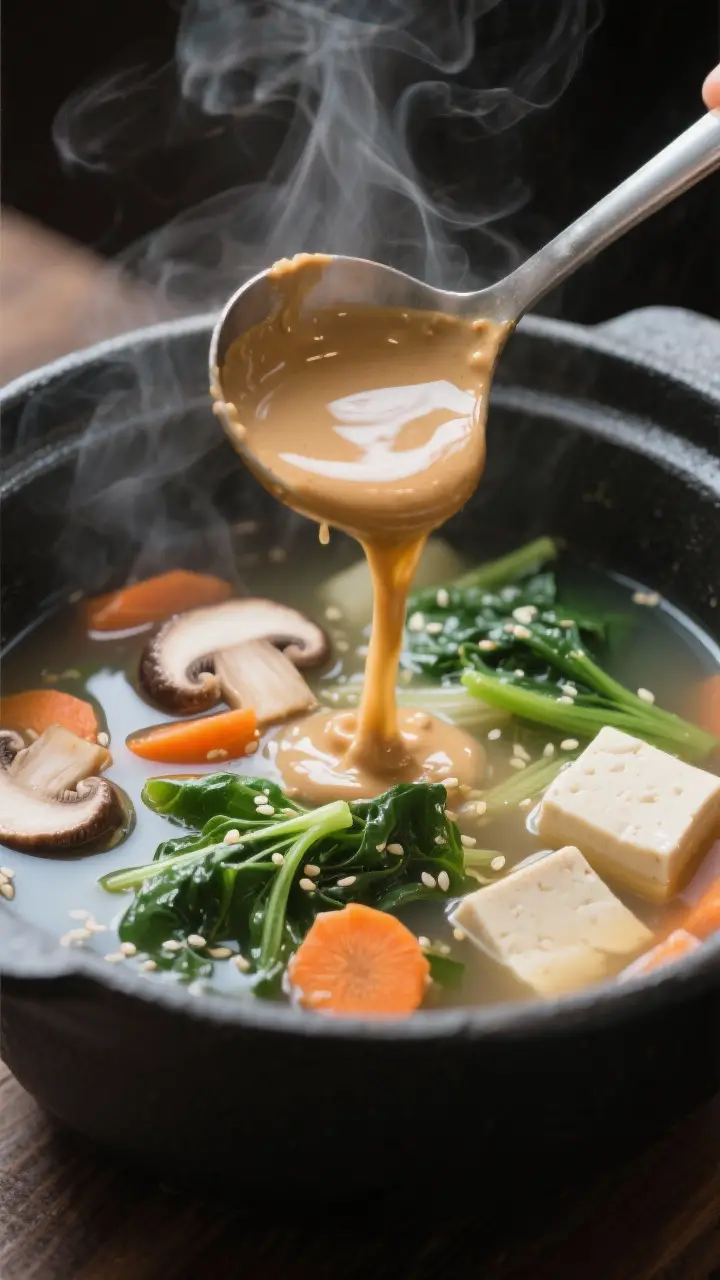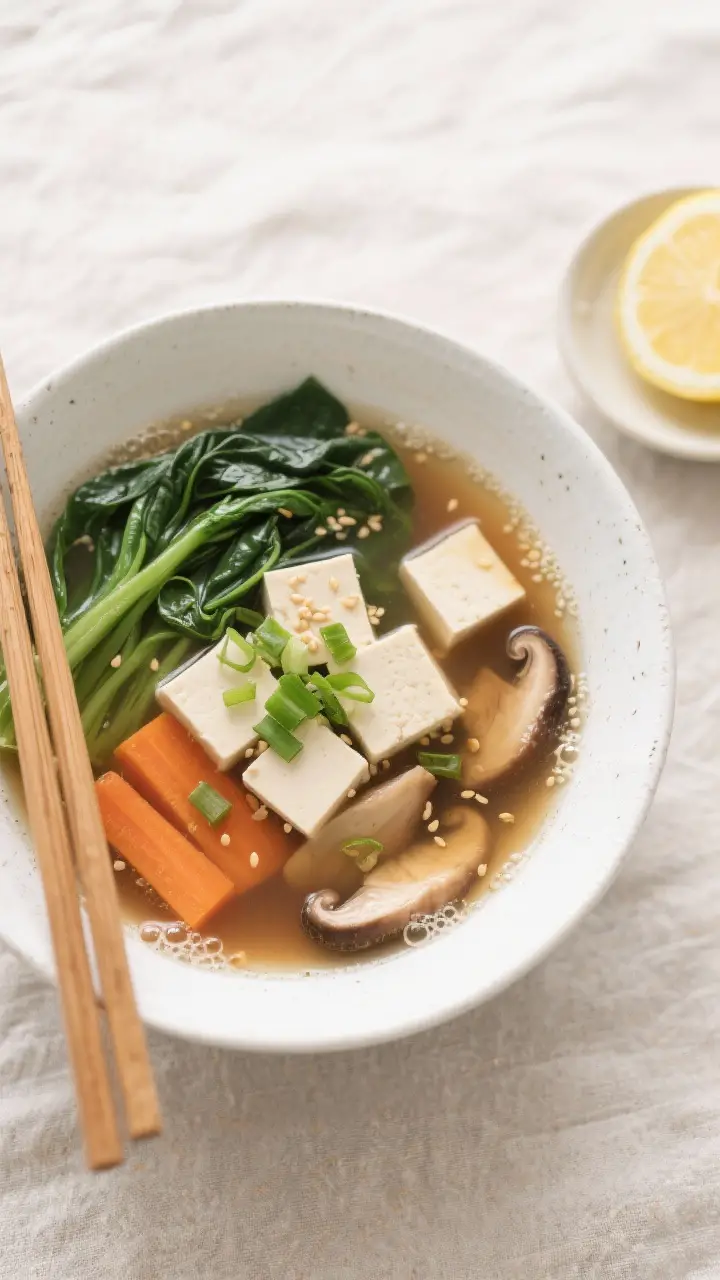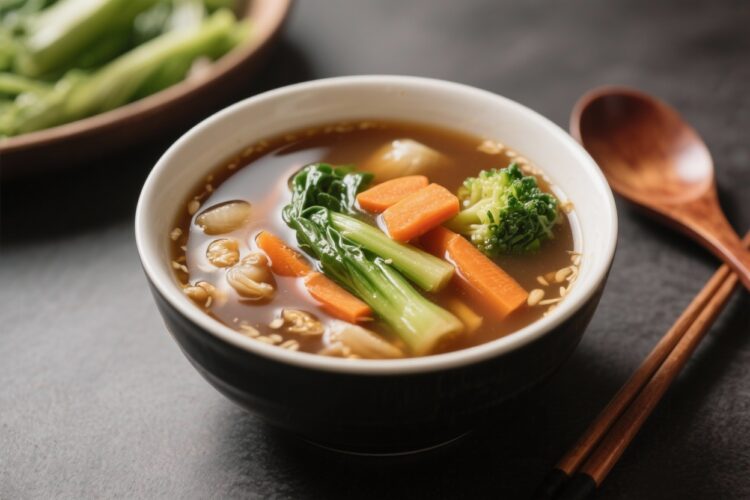Miso soup is the kind of comfort food that does a lot with a little. It’s warm, savory, and somehow both simple and satisfying. Adding fresh vegetables turns it into a more complete meal, with texture and color in every sip.
You don’t need fancy tools or hard-to-find ingredients to make it at home. With a few smart steps, you’ll have a pot of cozy, nourishing soup ready in under 30 minutes.
What Makes This Recipe So Good

- Quick and easy: Most of the cooking time is just simmering the vegetables until tender.
- Flexible ingredients: Use whatever vegetables you have—mushrooms, carrots, spinach, bok choy, or even frozen peas.
- Deep, savory flavor: Miso paste brings umami richness, and a simple dashi or broth gives the soup a clean backbone.
- Light but satisfying: It’s not heavy, yet it feels complete thanks to tofu, seaweed, and a mix of veggies.
- Great for weeknights: One pot, minimal prep, and easy cleanup.
Ingredients
- 4 cups dashi or low-sodium vegetable broth (traditional dashi gives the most authentic flavor)
- 3 tablespoons white or yellow miso paste (adjust to taste)
- 1 cup firm or silken tofu, cut into small cubes
- 1 cup sliced mushrooms (shiitake, cremini, or button)
- 1 small carrot, thinly sliced
- 1 cup chopped leafy greens (spinach, bok choy, or napa cabbage)
- 2 green onions, thinly sliced
- 1 tablespoon dried wakame seaweed (optional but recommended)
- 1 teaspoon sesame oil (optional, for aroma)
- 1 teaspoon soy sauce or tamari (optional, for depth)
- Salt to taste, if needed (miso can be salty, so taste first)
- Lemon or rice vinegar to finish (optional, a few drops brighten the soup)
How to Make It

- Prepare the base: Heat the dashi or vegetable broth in a medium pot over medium heat until steaming but not boiling.
- Soak the wakame: If using dried wakame, place it in a small bowl with warm water for 5 minutes. Drain and chop if the pieces are large.
- Add hardy vegetables: Stir in the mushrooms and carrots.
Simmer gently for 6–8 minutes until tender but not mushy.
- Add greens and tofu: Add spinach or bok choy, the rehydrated wakame, and the tofu cubes. Simmer for 2–3 more minutes, just until the greens wilt.
- Make a miso slurry: Ladle a small cup of hot broth into a bowl. Whisk in the miso paste until smooth.
This helps prevent lumps and preserves flavor.
- Turn off the heat: Remove the pot from the heat. Stir the miso slurry into the soup. Do not boil after adding miso, or the flavor and beneficial enzymes can fade.
- Season to taste: Add soy sauce or tamari if you want a deeper savory note, and a few drops of sesame oil for aroma.
Taste and adjust salt if needed.
- Finish and serve: Add the green onions. If you like a hint of brightness, add a few drops of lemon juice or rice vinegar. Ladle into bowls and serve warm.
Storage Instructions
- Refrigerator: Store leftovers in an airtight container for up to 3 days.
The vegetables may soften, but the flavor stays lovely.
- Reheating: Warm gently on the stove over low heat. Avoid boiling; miso loses its delicate flavor when overheated.
- Freezing: Not recommended. Tofu texture and miso flavor don’t hold up well in the freezer.
- Make-ahead tip: Keep the broth and cooked vegetables separate from the miso.
Reheat the broth, then whisk in miso right before serving.

Health Benefits
- Rich in probiotics: Miso is a fermented soybean paste. When not boiled, it may support gut health with beneficial microbes.
- Light on calories, big on nutrients: Vegetables like spinach, carrots, and mushrooms add fiber, vitamins, and minerals without heaviness.
- Plant-based protein: Tofu and miso provide a gentle protein boost, making the soup more satisfying.
- Hydrating and soothing: A warm, broth-based soup helps with hydration and feels easy on the stomach.
- Lower sodium option: Using low-sodium broth and adjusting the miso to taste lets you control salt levels.
Common Mistakes to Avoid
- Boiling the miso: This is the big one. Add miso off the heat to protect its flavor and delicate benefits.
- Overcooking vegetables: Mushy veggies make the soup feel flat.
Simmer just until tender.
- Skipping the slurry: Stirring miso directly into the pot can leave clumps. A small bowl and whisk make it smooth.
- Over-salting: Taste before adding soy sauce or extra salt. Miso and dashi are already savory.
- Using only one vegetable: A mix of textures—soft tofu, tender greens, and meaty mushrooms—keeps each spoonful interesting.
Recipe Variations
- Ginger miso soup: Add 1–2 teaspoons of freshly grated ginger to the broth for a warming, aromatic kick.
- Noodle upgrade: Stir in cooked soba or udon noodles to make it more filling.
Add the miso after the noodles go in.
- Hearty vegetable mix: Try snow peas, daikon radish, baby corn, or zucchini. Keep pieces small for quick cooking.
- Spicy miso: Add a little chili crisp or a dash of togarashi for gentle heat.
- Miso and corn: Sweet corn kernels pair beautifully with umami miso—great in late summer.
- Protein swap: Use edamame or tempeh cubes instead of tofu for a different texture. For non-vegetarian, add a few shrimp at the simmer stage.
- Broth options: Traditional kombu-katsuobushi dashi delivers classic flavor.
For vegetarian, use kombu and dried shiitake dashi or a clean vegetable broth.
FAQ
What kind of miso should I use?
White (shiro) miso is mild and slightly sweet, great for beginners. Yellow (shinshu) miso is a bit stronger and more savory. Red (aka) miso is bold and salty; use less of it or balance with extra broth.
Can I make it gluten-free?
Yes.
Use gluten-free miso and tamari instead of soy sauce. Check your broth label to be sure it doesn’t contain gluten.
Do I need dashi to make it taste authentic?
Dashi adds classic depth, but you can still make a tasty soup with vegetable broth. For extra umami, add a piece of kombu to the pot while heating, then remove before simmering the vegetables.
How do I keep tofu from breaking apart?
Use firm tofu, cut it into small cubes, and add it near the end.
Gentle simmering and minimal stirring keep the cubes intact.
Why is my soup cloudy or grainy?
Miso naturally makes the broth look a bit cloudy. Graininess usually means the miso didn’t fully dissolve. Whisk it in a small bowl with hot broth before adding to the pot.
Can I make it ahead for meal prep?
Yes, but keep the miso separate.
Reheat the broth and vegetables, then stir in miso right before serving to keep the flavor fresh.
How can I make it more filling?
Add noodles, extra tofu, or cooked brown rice. A soft-boiled egg on top is also a nice touch if you eat eggs.
In Conclusion
Miso soup with vegetables is simple cooking at its best—warm, clean, and full of quiet flavor. With a handful of affordable ingredients and a few easy steps, you can make a nourishing bowl any night of the week.
Keep the miso gentle, the veggies tender, and the seasonings balanced. Once you get the rhythm, you’ll have a base you can customize forever. It’s the kind of recipe that feels good to make and even better to eat.
Printable Recipe Card
Want just the essential recipe details without scrolling through the article? Get our printable recipe card with just the ingredients and instructions.

